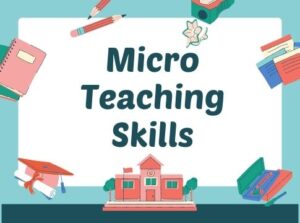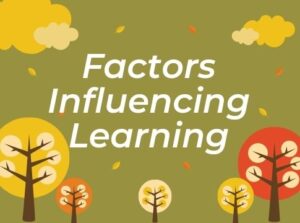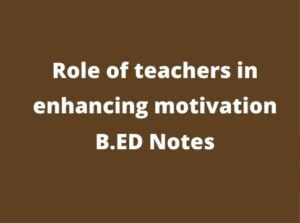Types of Learning |Domains of Learning by Bloom | Learning Outcome by Robert Gagne
Benjamin Bloom (1956) developed a taxonomy to differentiate the levels of Complexity of Learning. He classified 3 domains of learning
Domains of Learning by Bloom
- Cognitive
- Affective and
- Psychomotor domain
Cognitive Domain
It pertains to intellectual knowledge, skills and abilities. There are six levels of learning based on increasing levels of complexity
- Knowledge
- Comprehensive
- Application
- Analysis
- Synthesis and
- Evaluation
Knowledge:
- This category involves the recall of specific information, definitions, principles, generalizations, facts etc.
- It also involves the ability to classify, organize, sequencing, developing criteria etc.
Comprehensive:
- It is the ability to understand the verbal, pictorial or symbolic form, distinguish and explain concepts or predicting the consequences of an action.
Application:
- The application involves the ability to apply knowledge to real situation
- At this level of learning, children are able to demonstrate their ideas. This means the learner is able to use abstraction such as ideas, principles, theories, and methods to solve a problem in a particular situation
Analysis:
- Analysis is the ability to classify or breakdown ideas/theories/principles/material into constituent parts and explain/clarify the relationship between parts
- For example: Analyzing a report to identify assumptions, motivates, hypotheses or facts from the conclusion or analyzing pieces of communication to determine the relationship between its different parts.
Synthesis:
- It is the ability to put together parts and make something new or form a whole
- At this level of learning one is able to bring ideas together and put forward a revised interpretation or a new theory
Evaluation:
- It is the learning of value judgment. Children develop the ability to judge the value or worth of materials, ideas or method
- They learn to set standards for judgement and examine them based on criteria
Affective Domain
Affective domain is divided into hierarchical taxonomy (Krathwohl, Bloom and Masia, 1964). In affective domain the focus is on emotions and attitudes. There are 5 levels of Affective domains.
- Receiving (Attending)
- Responding
- Valuing
- Organization
- Characterization by a Value
Receiving (Attending):
- Exhibition of awareness or consciousness of an affect or Value (e.g. Awareness of aesthetic factors)
- Willingness to receive communication (listening to others Speak) and
- Controlled or select attention given to affects or value (discrimination of mood in music, alertness towards human value recorded in literature)
Responding:
- Paying active attention or expressing interest through acquiescence in responding (obedience or compliance, willingness to respond (voluntary participation, acceptance of responsibility) or satisfaction in response (enjoyment of self-expression, conversation or reading)
Valuing:
- Adoption of consistent behaviour that reflects an independent assessment of worth or characteristic attitude.
- It includes acceptance of a value to the point of being identified with it
- Pursuit of or preference for value (active participation in making arrangements of an art show) and
- Communication or conviction (devotion to ideas of democracy)
Organization:
- Gradual development towards a system of value in which interrelationships and predominance of particular values are determined
- It includes conceptualization of a value held (identifies attributes of an admired objects, forms judgement as a responsible society
Characterization by a Value or Value Complex:
- Development of a life outlook characterized by an internally consistent set of values
- It includes a generalized set or selective response a very high level (readiness or predisposition to revise judgement in light of evidence)
- Characterization by a philosophy of life or view of the universe (development of code of behaviour based on ethical principles consistent with democratic ideals)
Psychomotor Domain
This category of learning involves physical ability. Psychomotor domain has also been classified using taxonomy (Harrow, 1972). Five Levels of the psychomotor domains of learning
- Basic -Fundamental Movements
- Perceptual Abilities
- Physical Abilities
- Skilled Movements
- Nondiscursive Communication
Basis-Fundamental Movements:
- At this level, the learner develops basic locomotor movements (walking, running, jumping, hopping climbing etc)
- Nonlocomotor movements (pushing, pulling, swinging, stooping) and
- Manipulative movements (handling, gripping, grasping, manipulating)
Perceptual Abilities:
These includes
- Auditory perception (following instruction)
- Visual Perception (Dodging a moving ball)
- Kinesthetic perception (adjusting body in a handstand)
- Tactile perception (determining texture, identifying coins through touch)
- Coordinated perception (Jumping rope, punting, catching)
Physical abilities:
- Included in it are endurance or strenous effort (distance running, swimming), strength or muscular exertion (weightlifting, wrestling), flexibility or axial movements (toe touching, sit-ups, twisting exercise, ballet exercise) and agility or quick, precise movements (shuttle runn, typing, dodge ball)
Skilled Movements:
- A physical skill is define as the “degree of efficiency in performance of a specific, reasonably complex movement behaviour” The complexity of a skill distinguishes it from basic fundamental movements
- Activities include three types of skills used in sports, dance, recreation and manipulation into three categories (simple, compound and complex adaptive skills)
- Simple adaptive skills refer to basic fundamental movements (push-pull, piano playing)
- Compound adaptive skills requires skill in the simultaneous manipulation of a tool or implement in addition to skill in use of body (racket games).
- Complex adaptive skills requires mastering the mechanics of total body involvement (aerial gymnastics stunts)
- Each of the three types of skilled movement is further subdivided into four levels of proficiency (beginner, Intermediate, advanced, highly skilled)
Nondiscursive Communication
- This level of movement involves communication through bodily movements from facial expressions to dance compositions
- Its two subcategories are expressive movement (posture and carriage, gestures, facial expression) and interpretive movement (art forms of aesthetic and creative movement)
Learning Outcome By Robert Gagne
Robert Gagne (1985) employed a more cognitively oriented approach to conceptualizing learning. Gagne proposed that the interaction between the environmental stimuli and the cognitive states and processes of the child used in interpreting the environmental stimuli leads to learning outcomes.
Gagne identifies the following outcomes of learning:
- Verbal learning
- Intellectual skills
- Cognitive Strategies
- Attiudes
- Motor Skills
Verbal Learning
- When children respond to questions like, who is the prime minister of India?, What is the name of the first president of India? When did India become an independent country?, they show verbal learning.
- For the development of higher order intellectual skills children would need verbal information in the form of facts and principles
Intellectual Skills:
Gagne Categorized intellectual skills into three forms such as:
- Discrimination learning
- Concept learning
- Rule learning
Discrimination Learning
- Discrimination learning is about distinguishing objects based on their recognizable properties. For example, children show discrimination skills when they learn to differentiate between the letter b and the letter d or a cat from a puppy.
Concept Learning:
- In concept learning one learns to group objects, events or ideas. Children show concept learning when they recognize different types of dogs.
- When concepts are combined to form more abstract groupings, Gange called them ‘defined concepts’. Such concepts can be defined in terms of other concepts.
- For example, terms like socialism, democracy and honesty can be defined by reference to other concepts.
Rule Learning:
- Rule learning is the third intellectual skilled described by Gagne. We show rule learning when we stand in queue at a cinema counter. When children speak grammatically correct sentence they display rule learning.
- In maths class when children demonstrate that, the product of two negative numbers is a positive number, it is a rule learning. However, concept learning or rule learning does not make the learner able to define the concept or state the rules
Cognitive Strategies:
- Cognitive strategies refers to the capability of the child to internally organize skills that regulate the use of concepts and rule. These strategies help children to organize their cognitive process effectively
Attitude:
- Attitude is an acquired internal state that influences a student’s choice of personal action. Children may acquire an attitude towards parents/teachers that influences their behaviour at home or in school.
Motor Skills:
- Another type of learning outcome proposed by Gagne is a motor skills. Playing tabla or riding a bicycle involves physical capabilities.
- In such activities both cognitive and affective process are involved. The child may have a schema of how tabla is played as well as predisposition to link it or not
Conclusion:
- It is the ability to arrive at a conclusion on the basis of a limited number of observations about the characteristics of a large group. Children may learn to generalize a social settings or in experimental settings.
- In certain cases learning happens as a result of transfer of past learning to solve new problems
- For example, driving a two-wheeler may enhance learning to drive a four-wheeler.



